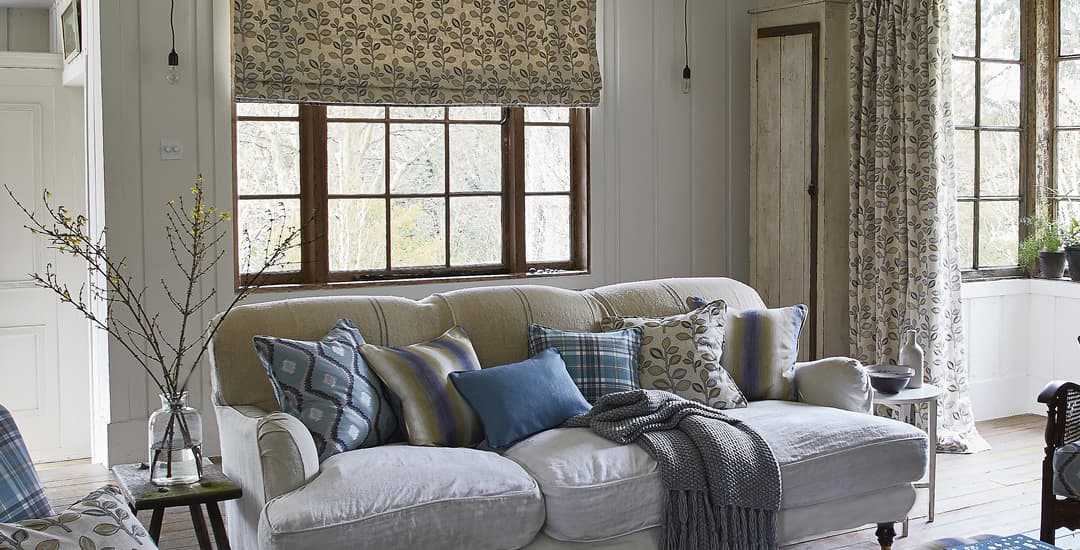
What are the best blinds for traditional home designs? In a way, this depends on what you mean by traditional; a country cottage, for instance, would probably suit a rather different type of blind than a former manor house, and a Victorian townhouse could call for something else again.
Knowing the best blinds for a traditional home design also relies heavily on the colour, pattern, and material choices made for the blind in question, as well as the blind’s type; although the type itself is hugely important too, and some more modern blinds would look rather out of place or jarring in a traditionally styled home.
In this blog post I will talk about what blinds are best for a traditional or classically styled home, based on both the blind’s type, and its finish, colour, and design.
What are the best blinds for traditional home design in terms of the various blind types?
The first blind that comes to mind as being an excellent choice for a traditional home is the Roman blind; these can fairly be described as a “classic” in blinds terms, which lend themselves well to more or less any traditional style, from a large coastal-facing property to a small country cottage, and from to a period property to a townhouse and beyond.
Wooden blinds too are more or less a universal fit for any traditional home design, although this does depend to an extent on your design aesthetic. Wooden blinds generally work better in natural-looking rooms, rooms looking out over natural backdrops or green space, homes near to the coast, and rooms with clean lines and a fairly structured style.
Wooden blinds don’t always work so well in traditional rooms that might be best described as “cosy,” which have a lot going on in them, formal rooms, or those with a cottage style aesthetic, although this is a rather sweeping statement and there are always exceptions!
Splitting opinions firmly down the middle now, I think it worth mentioning faux-wood blinds too; real purists, and those for whom the authenticity of their styling is integral, would definitely want to avoid these in a traditional home design.
But in purely visual terms, faux-wood blinds are virtually indistinguishable from the real thing, and so may be worthy of consideration alongside of wooden blinds if your thoughts are turning in that direction.
Roller blinds are a bit of a fence-sitter as well; they’re very, very common and popular and also fairly discreet and innocuous. In the right fabric and finish, roller blinds may complement many different traditional design styles, although they do top out to an extent if you’re getting into the realms of very large or grand rooms.
Both vertical blinds and aluminium Venetian blinds would be a bit of a reach for most people in a traditionally styled room, despite the fact that Venetian blinds as a whole are perhaps the longest established type of blind of all.
Aluminium, on the other hand, is rather newer to the market and isn’t the type of material you’d have found used in homes of any type up until the last few decades.
Vertical blinds too, while they’ve been around for decades now, would look a little futuristic in properties dating from or styled in a theme of any earlier than the 1960s.
Two types of blinds that are more or less definitely going to look jarring or out of place in a traditional home design are day and night blinds and perfect fit blinds (also known as pleated blinds) respectively; these are both very new additions to the window blinds market in the UK, and so would not style well in a traditional room.
What are the best blinds for traditional home design in terms of patterns and finishes?
The fabric or material choices, colours, and patterns/designs, as well as finishes, are all integral to determining what type of end result and effect or impact a blind has.
At its simplest, this means that geometric designs, neon colours, and very bold or bright shades will more or less be out for any traditional home.
For wood or faux-wood blind finishes, there isn’t really any unsafe choice or option to avoid; as wood is a natural material and faux-wood finishes are designed to emulate this.
Roman blinds are not sold exclusively in classical or traditional designs, although these do tend to make up the bulk of the market; even so, it is worth mentioning that the fabrics and materials used play a large part in determining what style they suit, along with the design or colour itself.
When it comes to both Roman blinds and roller blinds, anything overly shiny or with a sheen to it that comes from any material other than real silk might be out for most traditional homes, and even for plain coloured blinds, some colours or tones/shades might self-exclude from the selection process too.
Some Roman and roller blind patterns will be an obvious mismatch for a traditional home if they’re clearly very modern in appearance, but there remains a huge variety of options that have a classical print, pattern, or finish, which offer something to match traditional styles of more or less every type you can think of as well.
Florals and botanical prints remain ever-popular among our buyers of blinds for traditionally styled homes, and small, subtle, and delicate patterns are always in demand too.
Larger and bolder patterns don’t tend to work well in traditionally styled homes, with the notable exception of some art deco designs for homes dating from or styled to emulate that era.




